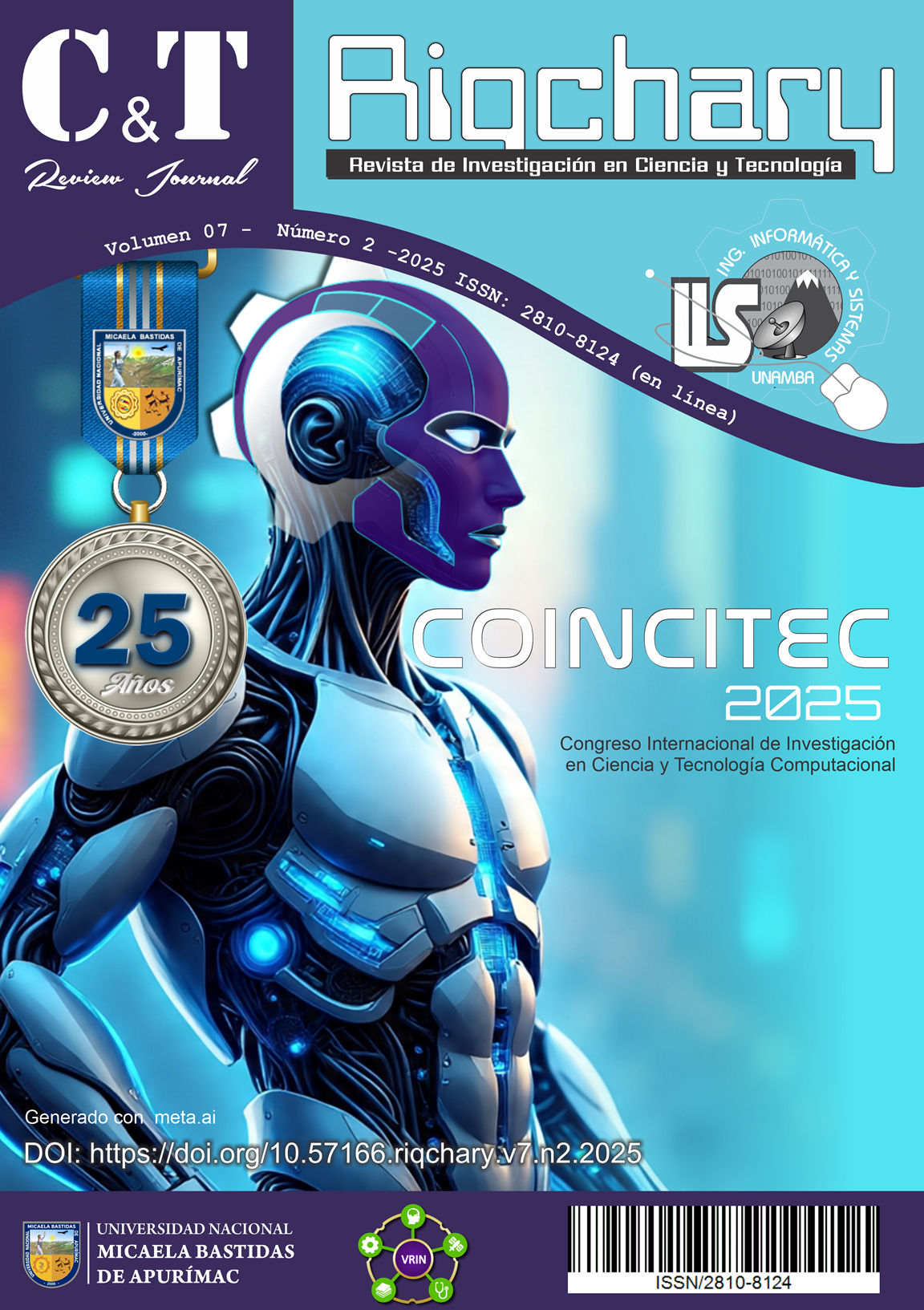Application of artificial intelligence to predict employee turnover in a supermarket in Juliaca – Puno
Main Article Content
Abstract
This study focused on the development and evaluation of an artificial intelligence model for predicting employee turnover in the fresh produce section of a supermarket located in Juliaca, Peru, and on identifying the main determinants of this phenomenon. A quantitative and predictive methodological approach was adopted, employing machine learning algorithms (Logistic Regression, Random Forest, XGBoost, KNN) on a database composed of 1,000 employee records. The methodology included data preprocessing, variable encoding, feature scaling, and the implementation of the SMOTE technique to counteract class imbalance. The findings revealed that the KNN model exhibited the superior predictive performance, achieving an F1-Score of 0.599. Feature importance analysis indicated that monthly salary, performance appraisal, and seniority were the most influential predictors. In conclusion, it is established that artificial intelligence represents a robust and feasible tool for proactive human resource management, empowering management to formulate focused and evidence-based retention strategies to mitigate turnover in the analyzed context.
Article Details

This work is licensed under a Creative Commons Attribution-NonCommercial-NoDerivatives 4.0 International License.
When an author creates an article and publishes it in a journal, the copyright passes to the journal as part of the publishing agreement. Therefore, the journal becomes the owner of the rights to reproduce, distribute and sell the article. The author retains some rights, such as the right to be recognized as the creator of the article and the right to use the article for his or her own scholarly or research purposes, unless otherwise agreed in the publication agreement.
How to Cite
References
M. N. Ahamad, “Employee retention and turnover: The role of human resource management practices,” International Journal of Social Science, Education, Communication and Economics, vol. 2, no. 1, pp. 1–10, 2023. [Online]. Available: https://kuey.net/index.php/kuey/article/download/2995/1904/7360
W. A. Al Suraihi, S. A. Samikon, A. H. A. Al Suraihi, and I. Ibrahim, “Employee turnover: Causes, importance and retention strategies,” European Journal of Busi-ness and Management Research, vol. 6, no. 3, pp. 1–10, 2021. [Online]. Available: https://doi.org/10.24018/ejbmr.2021.6.3.893
S. Alferes, “Predicting turnover intention and task performance among retail and hospitality employees: The role of role stressors, job resources, and organizational commitment,” DiVA Portal, 2024. [Online]. Available: https://su.diva-portal.org/smash/get/diva2:1882238/FULLTEXT01.pdf
A. Anand, “Analyzing employee retention in the retail sector: Best practices and challenges,” Journal of Business and Management, vol. 23, no. 8, pp. 45–52, 2021. [Online]. Available: https://www.abacademies.org/articles/analyzing-employee-retention-in-the-retail-sector-best-practices-and-challenges.pdf
S. P. Arce, “Propuesta de un plan de endomarketing para disminuir la rotación de personal en la empresa SICobra,” Repositorio Académico UPC, 2023. [Online]. Available: https://repositorioacademico.upc.edu.pe/bitstream/handle/10757/669924/Arce_SP.pdf?sequence=1
M. Atef, D. Elzanfaly, and S. Ouf, “Early prediction of employee turnover using machine learning algorithms,” International Journal of Electrical and Computer Engineering Systems, vol. 13, no. 2, pp. 135–144, 2022. [Online]. Available: https://ijeces.ferit.hr/index.php/ijeces/citationstylelanguage/get/ieee?submissionId=523&publicationId=523. https://doi.org/10.32985/ijeces.13.2.6
A. Benabou, F. Touhami, and M. A. Sabri, “Predicting employee turnover using machine learning techniques,” Acta Informatica Pragensia, vol. 14, no. 1, pp. 112–127, 2025. [Online]. Available: https://doi.org/10.18267/j.aip.255
R. Bohórquez, “Factores críticos que inciden en la retención del representante de servicio en los supermercados de Lima Metropolitana en los últimos dos años,” Repositorio Académico UPC, 2018. [Online]. Available: https://repositorioacademico.upc.edu.pe/bitstream/handle/10757/625207/Boh%C3%B3rquezO_R.pdf
M. Cubas, “Peru – Economic growth creates staff turnover issues,” Staffing Industry Analysts, Jan. 2, 2013. [Online]. Available: https://www.staffingindustry.com/news/global-daily-news/peru-economic-growth-creates-staff-turnover-issues
K. Dávila, “Impacto de la rotación laboral en el desempeño organizacional de las microempresas del sector manufacturero de Lima Centro,” Repositorio Acadé-mico UPC, 2019. [Online]. Available: https://repositorioacademico.upc.edu.pe/bitstream/handle/10757/648696/DavilaA_K.pdf?sequence=3
C. Espino, “Análisis predictivo: técnicas y modelos utilizados y aplicaciones del mismo – herramientas Open Source que permiten su uso,” Tesis de Grado, Uni-versitat Oberta de Catalunya, 2017. [Online]. Available: http://hdl.handle.net/10609/59565
F. Fallucchi, M. Coladangelo, R. Giuliano, and E. W. de Luca, “Predicting employee attrition using machine learning techniques,” Computers, vol. 9, no. 4, p. 86, 2020. doi:10.3390/computers9040086
A. Khaled et al., “Employee churn prediction using machine learning,” Internation-al Journal of Advanced Computer Science and Applications, vol. 12, no. 5, 2021. doi:10.14569/IJACSA.2021.0120501
M. Lazzari, M. Alvarez, and S. Ruggieri, “Utilizing machine learning to predict employee turnover in high stress sectors,” Journal of High Stress Environment Management, vol. 18, no. 2, pp. 45–59, 2022. [Online]. Available: https://www.researchgate.net/publication/380775878_Utilizing_machine_learning_to_predict_employee_turnover_in_high-stress_sectors
M. Madanchian, N. Hussein, and M. Fauzi, “Predictive modeling for HR deci-sion making: A study of employee turnover,” Journal of Management and Social Research, vol. 12, no. 1, pp. 205–218, 2024. [Online]. Available: https://jmsr-online.com/article/predictive-modeling-for-hr-decision-making-a-study-of-employee-turnover-205/
J. Pérez and L. Espichan, “La rotación de personal y su relación con el clima laboral del hipermercado Plaza Vea, sede Real Plaza – Trujillo, periodo 2016,” Repositorio Institucional UPN, 2016.
A. Raza, M. Najafi Zangeneh, and B. Raza, “Employee attrition prediction using machine learning techniques,” Journal of Big Data, vol. 9, no. 1, pp. 1–18, 2022. doi:10.1186/s40537-022-00582-9
C. Rosado and E. Villanueva, “La rotación de personal en el sector público,” Revista Universidad y Sociedad, vol. 13, no. 3, pp. 371–379, 2021. [Online]. Available: http://scielo.sld.cu/scielo.php?script=sci_arttext&pid=S1990-86442021000300371
D. Sola and P. Castillo, “Clima laboral y su relación con la rotación del personal en la empresa de call center teleatento del Perú, Lima 2021,” Revista Científica de la UCSA, vol. 9, no. 2, pp. 29–42, 2022. doi:10.18004/ucsa/2409-8752/2022.009.02.029
M. Umer, Z. Dacko Pikiewicz, and F. Li, “Analyzing employee attrition using explainable AI for strategic HR decision making,” Mathematics, vol. 11, no. 22, p. 4677, 2023. doi:10.3390/math11224677
Z. Yin, B. Hu, and S. Chen, “Predicting employee turnover in the Financial Compa-ny: A comparative study of CatBoost and XGBoost models,” Preprints.org, 2024. doi:10.20944/preprints202410.0072.v1
“Tackling Retail Employee Turnover: Strategies for Retention,” SparkPlug, Ac-cessed: Jul. 1, 2025. [Online]. Available: https://sparkplug.app/blog/tackling-retail-employee-turnover-strategies-for-retention





